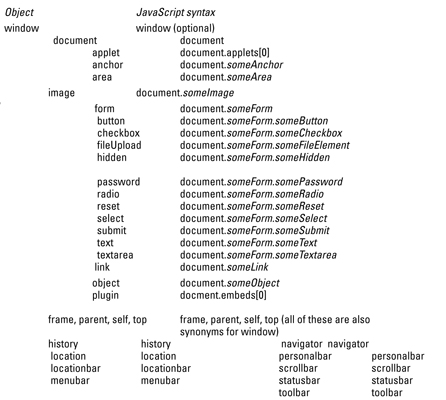>
JavaScript Object Terms
JavaScript is an object-based language. To understand how to interact with the document object model you work with in JavaScript, you need to understand some basic object-related terms. The following table shows the ones you're likely to find most useful:
| Term | JavaScript example |
|---|---|
| An object is a thing (noun). | A button is an object. |
| You can describe an object with adjectives (properties). | A button object has a name and a type. |
| An object can do things (methods). | A button object can click(). |
| An object can respond to events (event handlers). | A button can recognize when it's been clicked (onClick). |
>
>
>
Create a Hyperlink, Load a Web Page, and More with JavaScript
JavaScript helps you include all sorts of fun and interactive elements on a Web page, and the following table shows you how to do the kinds of tasks you want to be able to do with JavaScript. Whether you want to load a Web page or copy some code, check for the how-to here:
| To Do This | Do This in Navigator | Do This in Internet Explorer | ||||
|---|---|---|---|---|---|---|
| Load a JavaScript-enabled Web page | Double-click on the Navigator icon of a file on your machine; or File→Open Page | File→Open | ||||
| Look at someone else's JavaScript code | View→Page Source | View→Source | ||||
| Find a JavaScript-related news group | Window→ Mail & Newsgroups | Tools→Mail and News→Read News | ||||
| Copy and paste someone else's JavaScript code | Ctrl+C to copy; Ctrl+V to paste | Ctrl+C to copy; Ctrl+V to paste | ||||
| Create a hyperlink | <A> . . . </A> | <A> . . . </A> | Create an HTML form | <FORM> . . . </FORM | <FORM> . . . </FORM |
>
>
>
Troubleshooting JavaScript
JavaScript is a wonderful tool to use to create interesting and interactive Web pages, but every once in a while nothing works and you have no idea where to start to get things moving again. Not to worry; take a look at the following list for hints on what to do to get back on track (try them in this order):
Is your Web browser installed and configured correctly, including your communications stuff?
Is JavaScript enabled?
From Navigator: Choose Edit→Preferences→Advanced→Scripts & Plugins and select the Enable JavaScript For Navigator check box.
From Internet Explorer:
Choose Tools→Internet Options and click the Security tab
Click the Custom Level button
Scroll down until the Scripting category appears
Select the Enable radio button for these options: Active Scripting; Allow Paste Operations Via Script; and Scripting of Java Applets
Are all your JavaScript statements between <SCRIPT> and </SCRIPT> tags (except JavaScript statements attached to event handlers, which don't have to be)?
Does your HTML file work as it should by itself if you delete your JavaScript statements?
Do the names of your JavaScript variables all start with an alphabetic character (or an underscore)?
>
>
>
JavaScript Basic Cross-Browser Document Object Model
Like any other language, JavaScript has its own grammar and syntax — rules you need to follow to be understood. The following document object hierarchy lists the built-in objects you can work with in client-side JavaScript, along with their relationships to each other:

>
>
dummies
Source:http://www.dummies.com/how-to/content/javascript-for-dummies-cheat-sheet.html
No comments:
Post a Comment